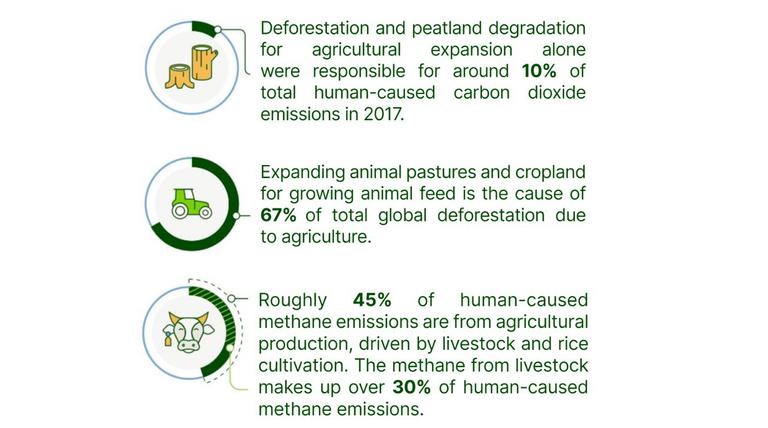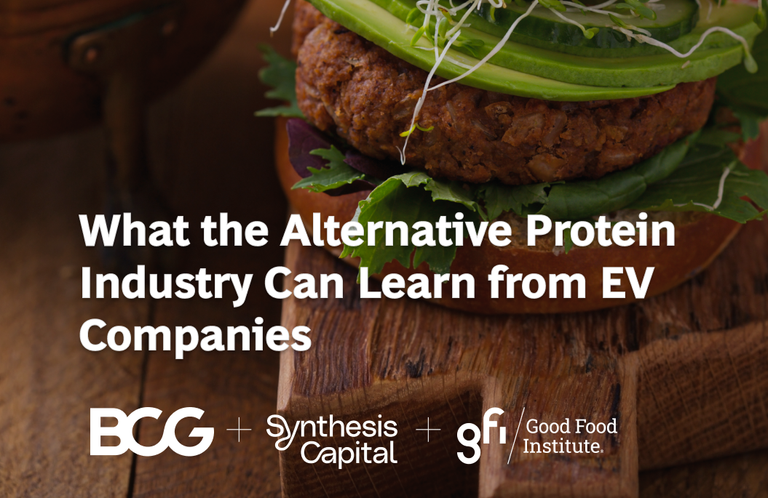New Report: AgTech for Reducing GHG Emissions
• Technology • Feature
We recently released a new report titled AgTech for Reducing Greenhouse Gas Emissions with Triple Helix. The full report is linked here, with highights related to animal agriculture summarized below.
Agriculture’s contribution to planet-warming greenhouse gas (GHG) emissions is often overlooked. Agriculture is responsible for a quarter of human-caused GHG emissions, with livestock alone contributing 15% [i]. In fact, animal agriculture contributes more greenhouse gasses than all the cars worldwide. If demand for animal products continues to increase, agricultural emissions could rise by 40% by 2050 [ii].
Greenhouse Gas Emissions from Animal Agriculture
Carbon Dioxide
Deforestation is one of the largest drivers of agricultural carbon dioxide emissions. In 2017, deforestation and degradation for agriculture contributed about 10% of human-caused CO₂ emissions [iii]. The demand for meat and dairy drives most of this deforestation, with animal agriculture responsible two thirds of global agricultural deforestation [iv].
Methane
45% of human-caused methane emissions are from agriculture, with livestock contributing two thirds of this agricultural methane [v], [vi]. Ruminants, like cows and sheep, release large amounts of methane during their digestive process. Methane, despite having a short atmospheric life, is 30-80 times more warming than carbon dioxide.

Reducing Greenhouse Gas Emissions from Animal Agriculture
Shifting away from production systems that currently rely upon animals is crucial for reducing greenhouse gas emissions from agriculture. Animal products are much more land intensive than plant-based or alternative protein products [vii], [viii]. A shift away from animal products would reduce agricultural land use and deforestation. Further, shifting away from beef, dairy, and lamb is key for reducing methane emissions.
At Synthesis, we invest in a range of alternative protein technologies with huge potential to reduce GHG emissions from agriculture. These technologies include:
Advanced Plant-Based
Processing plant ingredients in novel ways that closely biomimic animal products. Redefine Meat, a Synthesis portfolio company, uses a 3-D printing-like processes to produce realistic beef and pork alternatives.
Precision Fermentation
Engineering yeast, bacteria, and other microorganisms to produce specific ingredients, such as animal proteins or fats. Perfect Day, a Synthesis portfolio company, uses yeast to produce bovine whey protein.
Cultivated
Using cell culture and tissue engineering to produce identical whole products and ingredients. Upside Foods, a Synthesis portfolio company, makes cultivated chicken.
Molecular Farming
Engineering crops to produce specific ingredients, such as animal proteins and fats. Mozza Foods, a synthesis portfolio company, uses soybeans to produce bovine casein proteins.
Chemistry
Using chemistry to produce animal alternative ingredients. Savor, a Synthesis portfolio company, uses chemistry to make butter and other animal fat alternatives.

What's Needed
Even if all other emissions were stopped, food system emissions alone could keep us from hitting our 1.5° and 2°C climate targets [ix]. Agricultural emissions must drastically decrease, which requires a shift away from animal products.
Despite being responsible for 25% of GHG emissions, agriculture only receives 3% of climate finance [x]. More capital is needed from public, private, and philanthropic groups. Governments should offer grants, set ambitious emissions reduction targets, and shift subsidies away from high-emissions agricultural products toward low-emissions foods.
Consumer reluctance to shift diets is another key barrier to adoption. Alternative protein producers should innovate to produce delicious, healthy, and affordable alternative protein products. Stakeholders should work to increase awareness of the climate, nutrition, and other benefits of these technologies.
AgTech offers tangible, scalable solutions for reducing GHG emissions and must be prioritized for investment, policy attention, and public support.
Find the full report linked here, which covers these topics along with non-animal agricultural emissions.
References
[i] Sandalow, D. et al. (2021). Food and Climate Change InfoGuide.
[ii] Mbow, C. et al. (2019). Chapter 5: Food Security in Climate Change and Land. IPCC.
[iii] Mbow, C. et al. (2019). Chapter 5: Food Security in Climate Change and Land. IPCC.
[iv] Poore, J. & Nemecek, T. (2018). Reducing food’s environmental impacts through producers and consumers. Science.
[v] IPCC (2019). Climate Change and Land: Summary for Policymakers.
[vi] UNEP (2021). Global Methane Assessment: Benefits and Costs of Mitigating Methane Emissions.
[vii] Our World in Data (2021). If the world adopted a plant-based diet, we would reduce global agricultural land use from 4 to 1 billion hectares.
[viii] Good Food Institute (2023). Environmental impacts of alternative proteins.
[ix] Clark, M. A. et al. (2020). Global food system emissions could preclude achieving the 1.5° and 2°C climate change targets.
[x] World Economic Forum (2023). Green Returns: Unleashing the Power of Finance for Sustainable Food Systems.

